I wasn’t a good learner. I hated learning. I hated doing homework. I hated reading books. I hated everything school-related. That was many, many years ago. Since then, I learned how to learn. Today, I love to learn. I like to play with the stuff that I have to learn like if it was a toy. I like the challenge to learn things I’m bored of but now still can learn exceptionally well. The key for this was that I didn’t enforce learning. I just took another point of view at learning and tailored my learning approach to my learning type.
One technique that I learned (and appreciate the most) is the concept of waves. This method shapes my learning effectiveness very heavily. And I think that you might also be interested in how it works. It basically origins from Verena Steiner’s German book “Energiekompetenz” (in English like “competency in (personal) energy (optimization)”). I’ve combined that approach with the famous Pomodoro Technique from Francesco Cirillo. It’s a very easy method to get every kind of work done (where you otherwise would perhaps procrastinate). Here, I want to show how I integrated these two techniques to learn everything by heart (and thus went from a mediocre student to one of the best). You can also give it a try by applying these simple steps:
- Find out your personal daily energy curve
- Optimize for a well-balanced out curve
- Maximize the amplitudes
1. Find out your personal daily energy curve
This is the hardest part, but only because it takes some time and experimentation. You have to find out in which phases of the day you can do the following four kinds of work perfectly:
- Demanding tasks that take concentration or need a fresh mind, rational thinking and imagination E. g. rewriting, excerpting, reducing, “first contact” with the learning material and initial learning by heart. That will be your prime time.
- Lowbrow activities like drawing, write something off or creatively playing with the subject matter in general. That will be your low time
- Repeating the steps for learning by heart, prepare talks, review your writings. That will be your high time.
- Doing absolutely nothing (because you’re sleeping). This will be your down time.
Just take a sheet of paper and draw two axes: On the y-axis “energy” for your perceived energy level (where you can work very concentrated on a subject) and on the x-axis “time” for tracking down your energy level for per hour for one day. Just place that paper beside you and trace your energy. Then you should get something like this:
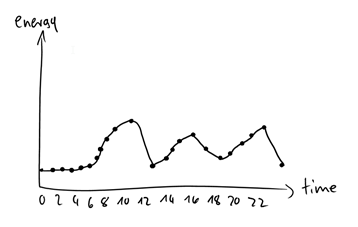
My tracked down energy level at the beginning
Now, you can derive some valuable information from this curve:
- Am I an early-morning person, a night person or in between?
- Where is my sweet spot for doing hard thinking work?
- Do I make enough pauses?
- Am I doing too much?
With the curve in the example above, I see that I’m neither a distinct morning nor a night person. I see that I can do the most work in the late morning. I also see, that there are almost no longer rest periods and that there is an abrupt ending of my day (which could be a reason for not sleeping well). I’m doing too much during the day with a suboptimal efficiency.
2. Optimize for a well-balanced out curve
The first step for optimizing this curve is to work out a well-formed wave. You can achieve that by first reducing the numbers of peaks to one or two. These peaks are the time where you’ll work very intense with your logical thinking areas of your brain. In my case, I went for a big first high peak in the morning (my prime time) and a second high in the evening (my high time). And I also tried to make room for pause times (low time or downtime):
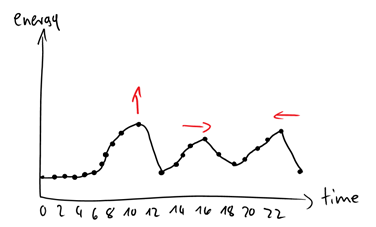
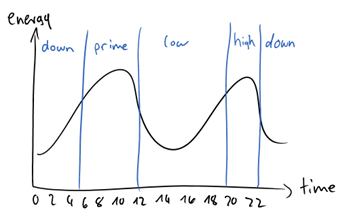
Reducing the peaks (before and after)
Now, the first key to success is the following: The more intense and demanding the work is that you’re doing during your peak times, the more intense have to be the pause times afterward. Note that I wrote “the more intense,” not “the longer.” Time isn’t important in the first place. And pause time doesn’t mean “do nothing.” It just means that we are shifting from using the logical thinking parts to the creative thinking parts of our brains. This has two reasons: Our brain is just another big muscle. If you train a single muscle only, you’ll get muscle ache very quickly. This results in the inability to use that muscle for intense workouts for a long time. So give specific parts of your brain a rest.
Does that mean “do nothing”? No! We just shift from tasks that require logical thinking (where, depending on the type of logical thinking, only very small parts of your brain are used very intense) to tasks that require creative thinking (where we try to use as much of the other parts of the brain as we can, that’s what’s creative thinking is about anyway 😉 ) and back again. With the help of this information, the result of your personal energy curve will be a well-balanced curve or a wave!
3. Maximize the amplitudes
We created a wave and adjusted the frequency. What’s left is to optimize the amplitudes (highs and lows). This is important because the more intense the highs and lows are, the more supportive the concept of waves will be.
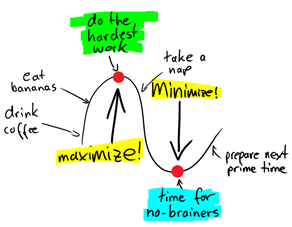
Maximize and minimize the waves
I discern here between intrinsic and external factors: Intrinsic factors are the working techniques that can directly support the maximization of the amplitude. These are the personal learning techniques you use (which is worth a blog series on its own). External factors are supportive means to optimize your learning environment, body and brain. This could be drinking coffee at the right time, eating bananas (for supporting positive amplitudes) or on the contrary: taking a nap (for supporting minimum amplitudes). In this blog post, I only show one external factor which is the primary mean that works for me to get you started.
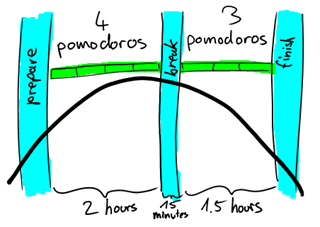
Separation of my prime time
The figure above shows how I divided my prime time. It starts with a preparation phase, where I get in the mood for the upcoming concentrated work. I organized my desk and prepared the subject matter by sorting or simply flipping through some material or reschedule my task list. This is enough to get my brain started. This phase could take longer or could be very short. It depends on my daily fitness. Then the real prime time follows. Here I use the
Then the real prime time follows. Here I use the Pomodoro Technique for working my tasks off. A pomodoro (from the Italian for “tomato”; and egg timers are tomato-shaped sometimes) is simply a specific period (traditionally 25 minutes) where you work 100% focused on your task. No disturbance allowed here (if that happens at the beginning, just write it down on a sheet of paper and continue your pomodoro). After the intense period, you take a break for 5 minutes, where you relax. After that, you start another pomodoro. After 2 hours (=4 pomodoros), you should rest for about 15 minutes before starting another block of pomodoros, then repeat. After 7-8 pomodoros, you’re exhausted, and you have to take a longer break. After that, you can transit to the creative thinking part.
After that, you can transit to the creative thinking part. That’s all that it needs 🙂
Summary
So here is the complete picture for my optimized energy level waves. Remember: There should always be a good balance between using the logical parts and creative parts of your brain.
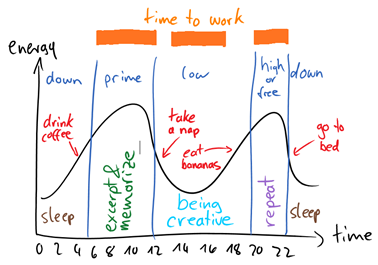
The complete picture
And don’t “force” you into learning. Learning is not a painful duty. Give always your best (and “best” means the best outcome you can achieve with your means and based on your form of the day).